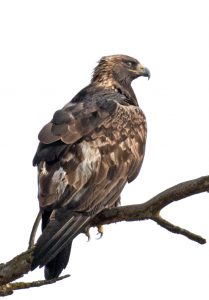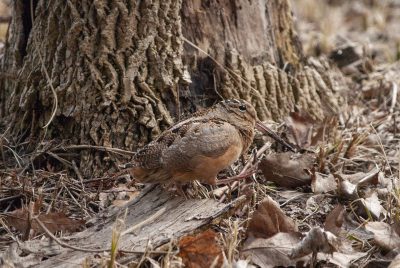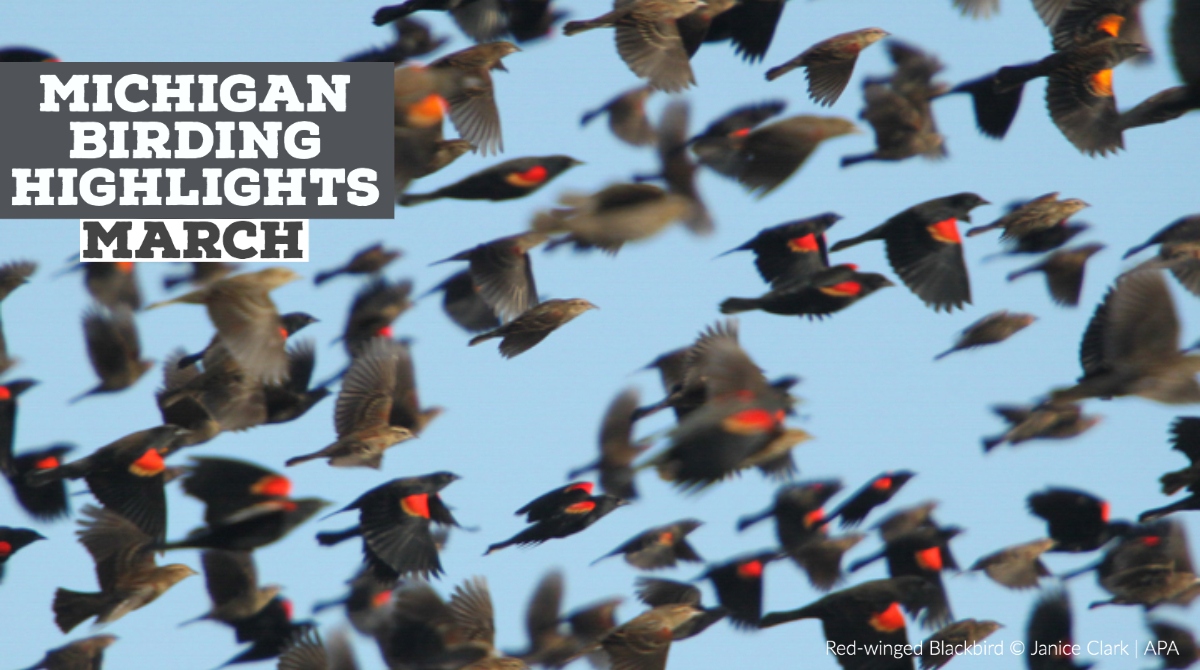It’s beginning to feel like spring! There are many recent reports of Red-winged Blackbird flocks and other Icterids (including Common Grackle, Rusty Blackbird, and Brown-headed Cowbird) occurring in southern Michigan. The angle of the sun and day length also lend to the feel of the seasons shifting, and spring equinox is only a couple of weeks away on March 20.
If you haven’t seen your favorite winter birds (flocks of Common Redpoll, Horned Lark, or even over-wintering waterfowl), now’s the time to seek them unless you want to wait until next winter! Check out our winter birding highlights and other recent birding blog posts for some tips on winter birding.

Golden Eagle. Photo by Kathryn Black
Raptors are also beginning to move north. Mackinaw Straits is a great place to watch for Golden Eagle, an early migrant, as well as the more commonly seen Bald Eagle. At Whitefish Point Bird Observatory, Michigan Audubon’s seasonal raptor watch begins on March 15. Early season (March to mid-April) is a great time to see both eagle species there, as well as many Red-tailed Hawk (most common), and the occasional Northern Goshawk, Red-shouldered Hawk, and a few early individuals of Sharp-shinned Hawk, Northern Harrier, Peregrine Falcon, and others. Last spring was pretty snowy and cold at Whitefish Point; this spring looks to be slightly warmer on average, but still be prepared with warm layers if you bird in the northern part of the state. If you’re new to hawkwatching, the Hawk Migration Association of North American has a great intro to hawkwatching guide.
Breeding behaviors and breeding seasons vary in timing and complexity for different bird species. Sharp-tailed Grouse are beginning to lek this month (and can be found in open lands such as those in the Eastern Upper Peninsula). Lekking behavior is exciting to watch as the male grouse find their place in the mating dominance structure through strutting, stomping, and the occasional tussle with another male. Check out some incredible photos of this behavior from Straits Area Audubon Society.

American Woodcock. Photo by Diana Duffy
American Woodcock also begin their delightful breeding displays this month and next! These shorebirds will find a patch of open habitat to do their “sky dance” and peenting, where males hope to attract the notice of females. Males will strut in a small patch of ground they’ve claimed, making nasally “peent” calls, before flying vertically about 250 to 350 feet in the air, then fluttering downward in a zig-zagging spiral while chirping vocally and making a twittering sound with the air movement through specialized wing feathers. If you’re quick and sharp-eyed, and it’s not too dark out yet (woodcock display at dusk), try focusing on the male woodcock while he’s in the air and watch as he makes his way back to the ground where he begins the whole display and peents once again.

Purple Martin. Photo by USFWS
Other breeding birds use human-provided housing for their nesting, including Purple Martin (which are on their way — check out this eBird sightings map) and Eastern Bluebird. Some have already noted early nesting behaviors, with bluebirds starting to line nest boxes with grasses. Now is the time to clear out old nests from last summer to provide clean, fresh nesting locations for these cavity-nesting species. Purple Martin housing can be opened in mid to late March, but make sure to keep an eye out for invasive House Sparrow and European Starling. For more information on nest boxes and monitoring nests, check out the recent webinar “Backyard Bird and Nest ID with NestWatch.”
For more information and community support for hosting Purple Martin, visit the Purple Martin Conservation Association website and join the Facebook group Michigan Purple Martin Friends.
Birdcast is starting up for the spring season, which can be an invaluable source of information for learning about the timing and intensity of bird movements and conservation efforts, such as reducing bird collisions with windows during peak movements. Analysis of weather patterns predicted a warming trend in March with more intense early migration movements than average. Check out their report and go out birding to contribute to community science data collection!
Species to watch for in early migration movements include waterbirds (geese, swans, ducks), Turkey Vulture, eagles and other raptors, American Woodcock, sparrows, and blackbirds.
Soon you’ll be seeing and hearing all sorts of migrating birds heading north after spending much of the year in migration and on their wintering grounds. This is a great time to brush up on your bird calls before your favorite songsters arrive back in Michigan. And consider being part of global community science data collection by contributing your sightings to eBird — it’s easy and fun!
Happy birding!
~ Linnea Rowse, Michigan Audubon conservation program coordinator

